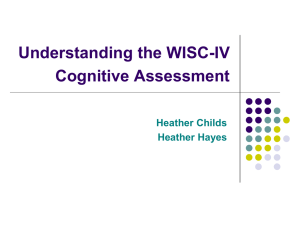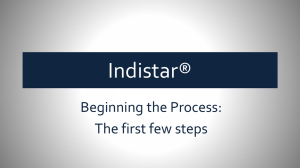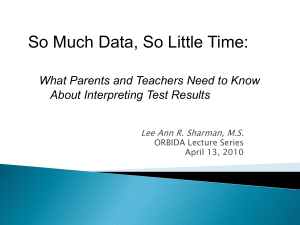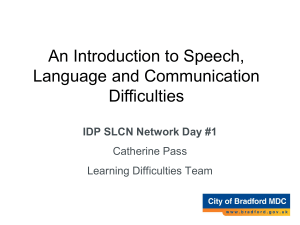WISC-IV title
advertisement
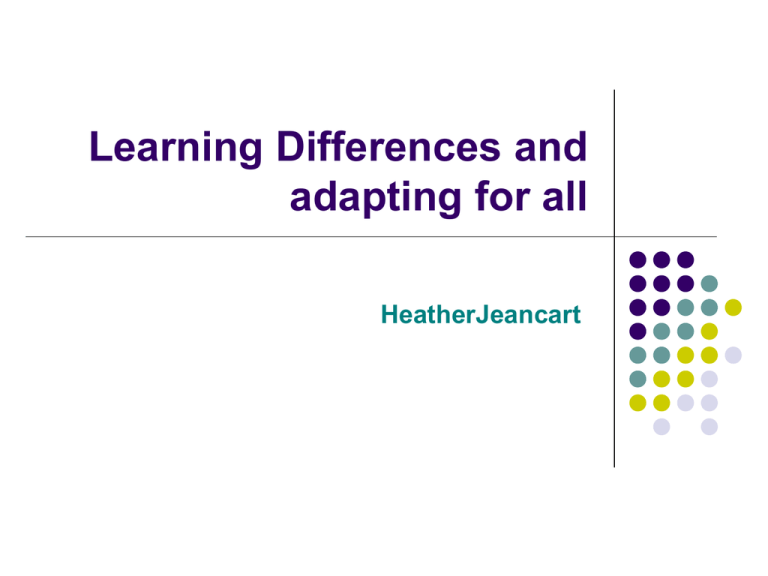
Learning Differences and adapting for all HeatherJeancart Agenda Simulation activity Learning difficulties – various ways they can manifest. Learning Difficulties Differences in ability: Verbal thinking and reasoning Visual thinking and reasoning Memory Processing speed Auditory processing Sensory difficulties Mental health Attentional difficulties Full Scale Intelligence Quotient (FSIQ) Classifies overall intellectual ability within a range Extremely Low (<69) Borderline (70-79) Low Average (80-89) Average (90-109) High Average (110-119) Superior (120-129) Very Superior (>130) Low scores High scores Verbal Comprehension Index (VCI) Ability to understand and use language Ability to think and reason using words Knowledge of verbal concepts and language Verbal Comprehension Index Low scores - difficulty with group discussions, auditory memory, reasoning aloud, reading, writing and expressing their ideas, multi-step directions High scores - good writing skills and ability to express their ideas, good vocabulary, careers that involve writing (University professors, authors) VCI Strategies 1. Encourage the student to paraphrase instructions and directions 2. Teach with visuals, demonstrations, videos etc. as learning solely through verbal information is difficult for this student 3. Encourage the use of graphic organizers 4. Avoid multi-step directions and supplement directions with visuals 5. Provide non-verbal activities to help the student de-stress 6. Supply study guides for text and summaries for novels 7. Highlight key vocabulary/major concepts in student’s texts or assignments VCI Strategies 8. Drill to mastery high frequency word & phrase list 9. Relate new information to acquired knowledge. 10. Provide specific vocabulary instruction (prefixes, suffixes, etc.) 11. Use vocabulary that is understood by the student 12. “Comic Life” allows the student to create a visual representation of a story as they have difficulty expressing themselves verbally. Accompanied with an oral component, this could be used as an alternative assignment. 13. “World Book Discover” offers engaging reference resources for students who struggle due to language or learning difficulties. Perceptual Reasoning Index (PRI) Ability to think and reason using pictures/visual information To see what is being asked To understand and respond, and to organize information in ones head through images To manipulate abstract visual thoughts (visual spatial skills) To reason with rules, generalizations, and logical thinking Perceptual Reasoning Index Low scores - difficulty with puzzles learning to read, learning math facts & formulas, poor visual-spatial skills, gets lost easily, won’t gravitate to a SMART board, uninterested in video games High scores - hands on activities, careers in construction or engineering, learns well with visuals and demonstrations, good visual-spatial skills PRI Strategies 1. Provide verbal information along with visual presentations 2. Make an effort to write neatly on the board and on worksheets 3. Reduce the amount of visual information on a page so that the student may more easily focus on the information at hand 4. Use a larger font for printed materials 5. Minimize copying activities by providing information on worksheets or handouts 6. Have the student use graph paper to assist him or her in lining up the numbers/letters properly and for guiding spaces between words 7. Highlight or underline important phrases in the students assigned reading 8. Assign fewer questions, and adjust the level of difficulty to suit the student PRI Strategies 9. Teach word processing skills 10. Allow for extra time for written tasks 11. Accept oral reports - use “Audacity” software to record 12. Provide writing guides to help him organize his written work (e.g., graphic organizers, Venn diagrams, etc.). 13. Consider alternative methods, other than a written test, to check understanding of a concept 14. Give extra time (usually time and a half or double time) 15. Allow a calculator for math activities 16. Provide a model or example if possible 17. Teach social skills as needed. - http://www.thewatsoninstitute.org/teacher-resources2.jsp Working Memory Index (WMI) Ability to hold information in your head and manipulate it in some way Measures attention, concentration, working memory, ability to encode information, and rehearsal strategies Working Memory Index Low scores - poor short term memory, difficulty with self-monitoring, multi-step directions, organization, spelling, reading, & math High scores - good short term memory & ability to sustain attention, good at spelling, reading, and math calculation skills WMI Strategies 1. Check hearing 2. Seat student close to the teacher 3. Encourage and teach good listening skills (eyes on teacher, active listening, asking questions, writing notes) 4. Teach memory enhancing techniques such as mnemonics, rehearsal, repetition, visualizing/verbalizing, categorizing, etc (Dean, M. (2008). Working memory and academic learning: Assessment and intervention) 5. Simple step-by-step directions vs. multi-step accompanied with visuals 6. Ask student to paraphrase directions and demonstrate how to do tasks 7. Teach note-taking skills or use a tape recorder during lectures (Use “Smart Notebook” to make a video tutorial of a lecture so the student can watch it on a computer, I-pod, or Smart Board) 8. Allow alternatives to written exams (oral take-home, projects, presentations) WMI Strategies 9. Allow “open book” or memory aids for assignments/quizzes 10. Provide more time or avoid timed tasks to complete tasks and process information 11. Reduce quantity of work in favor of quality 12. Avoid timed tasks 13. Provide notes from another student 14. Speech-to-text (if objective includes a writing component) otherwise accept a voice recording. (i.e. through the SRSD program “Audacity”) 15.Cuing with closed questions or with a choice versus open ended questions 16.Teach the student how to effectively use a daily agenda 17.Provide body breaks (lifting self out of desk, doing pushups against desk) 18.Index cards or mastery notebooks may be used to (a) keep vocabulary words/definitions, spelling words, and formulas; (b) for sentence starters to help focus what needs to be done to start the task or for a transition; (c) show examples of what work is supposed to look like and Processing Speed Index (PSI) Ability to respond to simple, visual motor tasks quickly, especially when under pressure to maintain focus, attention and concentration. Processing Speed Index Low scores - difficulties with tasks such as copying notes from the board & working under time pressures, poor perceptual discrimination ability High scores - mental quickness, good computer skills, ability to work under pressure, good motivation, persistence, and perceptual discrimination ability PSI Strategies 1. Develop fine motor coordination through appropriate activities 2. Teach how to skim and scan for information in a text. 3. Give student more time to process information – reduce quantity of questions in order to increase the quality of answers 4. Chunk work so that it is not visually overwhelming 5. Provide time and a half to double time for exams and questions or allow take home exams. Wait for a response to questions and cue if necessary. 6. Avoid timed tasks 7. Photocopy the notes of another student. Copying notes and copying from the board are difficult for these students. 8. Teach computer skills - word processing, text to speech software, speech to text software and programs. 9. Highlight math symbols as they can be easily confused Sensory Difficulties How Does Your Engine Run Program (Alert Program) Consider your students response to: Lights (flourescent vs. natural) Sound (bells, alarms, room noise level) Touch (clothing, personal proximity, pressure) Movement (what calms/gets the student going) Mental Health Anxiety Depression ADHD Mood disorders Life events Divorce Family abuse Alcoholism in family Children in foster homes ADHD 3 types: Hyperactive-Impulsive Type, Inattentive Type, ADHD Combined See handout (ADD/ADHD Iceberg) Impaired sense of time Sleep disturbances Delay in maturation Difficulty learning from rewards and punishment Other conditions Learning difficulties Low frustration tolerance Differentiation
